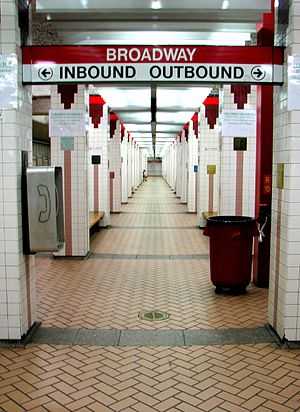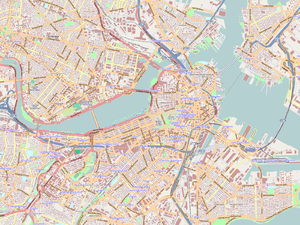Broadway (MBTA station)
BROADWAY | |||||||||||
|---|---|---|---|---|---|---|---|---|---|---|---|
 The island platform at Broadway Station, tracks are to left and right of the parallel rows of columns | |||||||||||
| Location | Intersection of Dorchester Avenue and Broadway, South Boston, MA | ||||||||||
| Coordinates | 42°20′34″N 71°03′26″W / 42.3429°N 71.0572°WCoordinates: 42°20′34″N 71°03′26″W / 42.3429°N 71.0572°W | ||||||||||
| Owned by | Massachusetts Bay Transportation Authority | ||||||||||
| Line(s) | |||||||||||
| Platforms | 1 island platform | ||||||||||
| Tracks | 2 | ||||||||||
| Connections |
| ||||||||||
| Construction | |||||||||||
| Disabled access | Yes | ||||||||||
| History | |||||||||||
| Opened | December 15, 1917 | ||||||||||
| Traffic | |||||||||||
| Passengers (2009 daily) | 4,200[1] | ||||||||||
| Services | |||||||||||
| |||||||||||
| Location | |||||||||||
 | |||||||||||
Broadway is a station on the Red Line subway at the intersection of Dorchester Avenue and Broadway in South Boston, Massachusetts. It was opened on December 15, 1917 as part of the Dorchester Extension of the "Cambridge Connection" from Downtown Crossing (formerly Washington station) to Andrew. The station has a single island platform to serve the two tracks. Broadway was planned to be a stop on the Urban Ring Project, which is currently shelved due to lack of funding.
Station layout
| G | Street Level | Exit/Entrance |
| M | Mezzanine | Fare control, to entrances/exits |
| P Platform level |
Inbound | ← Red Line toward Alewife (South Station) |
| Island platform, doors will open on the left | ||
| Outbound | → Red Line toward Ashmont or Braintree (Andrew) → | |
History
After the Cambridge Tunnel was completed between Harvard and Park Street in 1912, work began to extend the line south to Dorchester. Rather than being opened all at once, the second section was opened station-by-station as soon as possible due to popularity. Extensions opened to Washington (Downtown Crossing) in 1915, South Station Under in 1916, and to Broadway on December 15, 1917. Broadway was the southern terminus of the line until Andrew opened on June 29, 1918.[2] With the exception of Park Street - which was built with three platforms to handle crowds - Broadway was the only station on the original Cambridge-Dorchester Tunnel with an island platform (rather than two side platforms) in order to facilitate transfers through its three levels. Not until Columbia and Savin Hill opened in 1927 were there other island platforms used on the line.
Broadway station was originally built as a three-level station, with six stairways to allow easy transfer between streetcars and subway trains. Some streetcars stopped at a surface-level platform, others in a tunnel just below ground, while subway trains used the lowest-level tunnel. Each level consisted of two tracks and an island platform.[3] The street-level platform served streetcars that ran from the Tremont Street Subway to City Point and South Boston via the Pleasant Street Portal and Broadway. Buses replaced the single line to Bay View (which originally used the middle-level tunnel) in 1929, but the City Point line lasted until 1953 before being bustituted.[3]
In 1985, Broadway underwent a major renovation which included lengthening the platform to allow the use of 6-car trains on the Red Line.[2] Elevators were installed, making Broadway one of the first older stations on the system to be modified for handicapped accessibility.[4]
In October 2012, Broadway became the 4th station in the system (after the Red Line platforms at Park Street, Downtown Crossing, and South Station) to receive a digital countdown clock which shows when the next two trains in each direction will arrive. The sign was part of a pilot program which was expanded to much of Red, Orange, and Blue Lines later that year.[5]
Streetcar tunnel
The middle-level streetcar tunnel ran from a portal on Foundry Street south to another in the median of Dorchester Avenue. Service lasted only until October 14, 1919 - just after Andrew opened - since Andrew provided more convenient service to South Boston and eliminated unprofitable running on an industrial section of Dorchester Avenue.[6] The Dorchester Avenue portal was filled in December 1941, but much of the tunnel is still extant.[6]
The streetcar tunnel saw several adaptive reuses. In the 1930s, the Boston Elevated Railway attempted to grow mushrooms in the tunnel, and in the 1980s it was used to test tactile platform edging for blind passengers.[7] The 1985-built fare lobby occupies a section of the old streetcar platform and tunnel. After the September 11th attacks focused attention on infrastructure safety preparedness, the MBTA used the tunnel to train firefighters to respond to a burning train.[7] Until 2012, passerby could peer through a fence fronting the concrete portal on Foundry Street and see into the old tunnel.
In mid 2012, the MBTA started construction on an $10 million emergency training center located in the old streetcar tunnel, to replace the previous equipment. The $8.8 million facility, paid for with Department of Homeland Security funding, includes 2 Blue Line and 1 Green Line cars plus a Silver Line bus. The first Blue Line car was lowered into the Foundry Street Portal by crane in September 2012.[8] The facility opened on June 12, 2013.[9]
-
Northbound side of abandoned streetcar tunnel
-
Southbound side of abandoned streetcar tunnel
-
Arch of streetcar tunnel visible in fare lobby
Bus connections
Three MBTA bus routes serve Broadway station. The 9 and 11 are the remains of the streetcar routes that once ran through the station at street level.
- 9 City Point - Copley via Broadway Station
- 11 City Point - Downtown via Bayview
- 47 Central Square, Cambridge - Broadway Station via BU Medical Center routes.
References
- ↑ "Ridership and Service Statistics" (PDF). Massachusetts Bay Transportation Authority. 2010. Retrieved 24 February 2012.
- ↑ 2.0 2.1 Belcher, Jonathan (24 May 2013). "Changes to Transit Service in the MBTA district" (PDF). NETransit. Retrieved 13 June 2013.
- ↑ 3.0 3.1 O'Regan, Gerry (2005). "MBTA Red Line". NYCsubway.org. Retrieved 3 March 2012.
- ↑ Tran Systems and Planners Collaborative (24 August 2007). "Evaluation of MBTA Paratransit and Accessible Fixed Route Transit Services: Final Report" (PDF). Massachusetts Bay Transportation Authority. Retrieved 12 June 2013.
- ↑ Rosso, Patrick D. (19 October 2012). "Broadway Station gets new countdown sign; more coming to Red Line". Boston Globe. Retrieved 22 October 2012.
- ↑ 6.0 6.1 Clarke, Bradley H. (2003). Streetcar Lines of the Hub. Boston Street Railway Association. p. 33. ISBN 0938315056.
- ↑ 7.0 7.1 Bierman, Noah (26 December 2009). "Transit archeology: Tour of abandoned subway network offers a glimpse of how the T was built". Boston Globe. Retrieved 7 August 2013.
- ↑ Werthmann, Melissa M. (17 September 2012). "Subway car is added to MBTA underground training facility for emergency workers". Boston Globe. Retrieved 22 October 2012.
- ↑ Powers, Martine (12 June 2013). "MBTA sets up disaster training center in tunnel". Boston Globe. Retrieved 12 June 2013.
External links
| Wikimedia Commons has media related to Broadway (MBTA station). |
| ||||||||||||||||||||||||||||||||||||||||||||||||||||||||||


